India's Sustainable Development Goals: Healthcare Report Analysis
VerifiedAdded on 2020/02/24
|8
|2733
|266
Report
AI Summary
This report provides a comprehensive overview of India's endeavors to achieve the Sustainable Development Goals (SDGs) with a specific focus on healthcare. It highlights the critical importance of India's health development for global well-being, given its large population and socioeconomic...
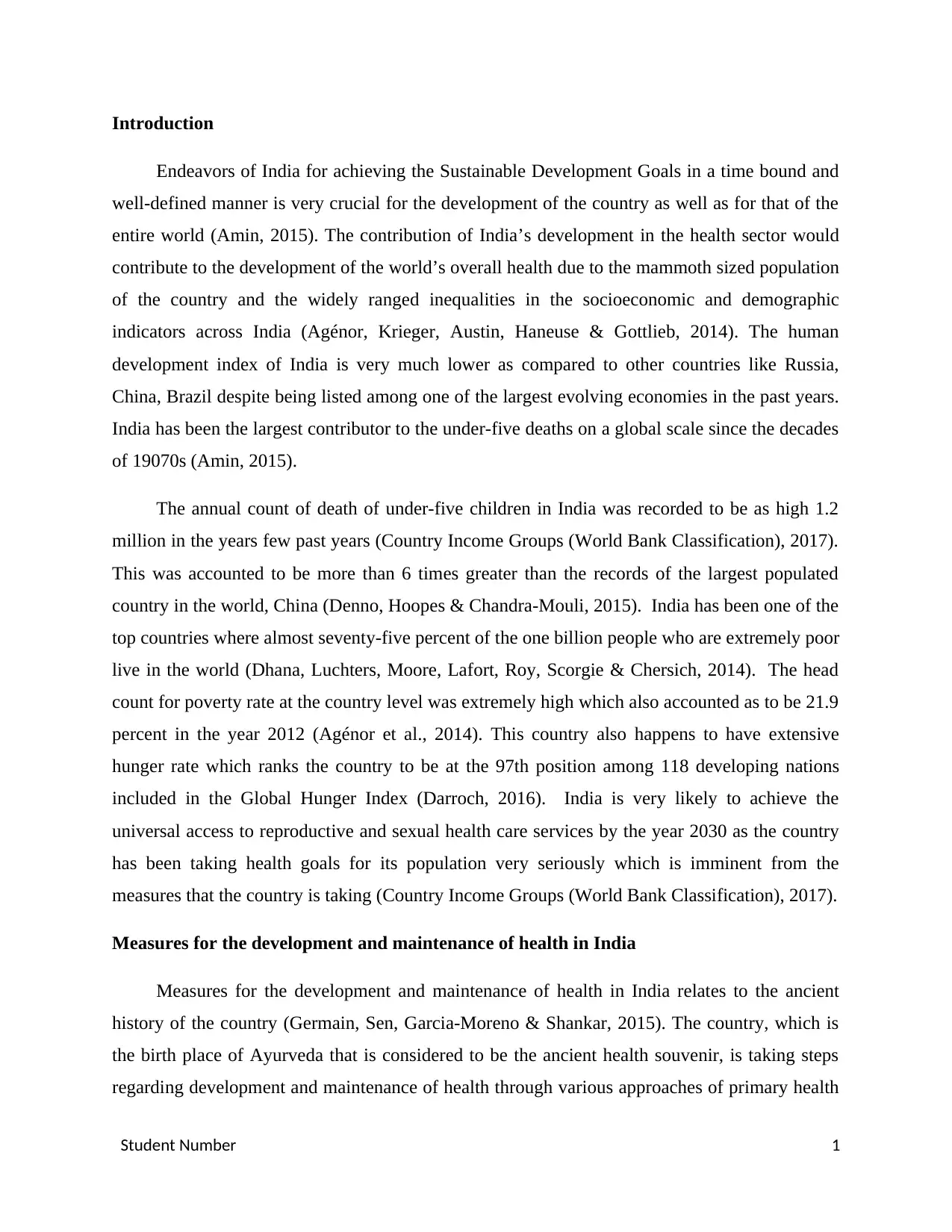
Introduction
Endeavors of India for achieving the Sustainable Development Goals in a time bound and
well-defined manner is very crucial for the development of the country as well as for that of the
entire world (Amin, 2015). The contribution of India’s development in the health sector would
contribute to the development of the world’s overall health due to the mammoth sized population
of the country and the widely ranged inequalities in the socioeconomic and demographic
indicators across India (Agénor, Krieger, Austin, Haneuse & Gottlieb, 2014). The human
development index of India is very much lower as compared to other countries like Russia,
China, Brazil despite being listed among one of the largest evolving economies in the past years.
India has been the largest contributor to the under-five deaths on a global scale since the decades
of 19070s (Amin, 2015).
The annual count of death of under-five children in India was recorded to be as high 1.2
million in the years few past years (Country Income Groups (World Bank Classification), 2017).
This was accounted to be more than 6 times greater than the records of the largest populated
country in the world, China (Denno, Hoopes & Chandra-Mouli, 2015). India has been one of the
top countries where almost seventy-five percent of the one billion people who are extremely poor
live in the world (Dhana, Luchters, Moore, Lafort, Roy, Scorgie & Chersich, 2014). The head
count for poverty rate at the country level was extremely high which also accounted as to be 21.9
percent in the year 2012 (Agénor et al., 2014). This country also happens to have extensive
hunger rate which ranks the country to be at the 97th position among 118 developing nations
included in the Global Hunger Index (Darroch, 2016). India is very likely to achieve the
universal access to reproductive and sexual health care services by the year 2030 as the country
has been taking health goals for its population very seriously which is imminent from the
measures that the country is taking (Country Income Groups (World Bank Classification), 2017).
Measures for the development and maintenance of health in India
Measures for the development and maintenance of health in India relates to the ancient
history of the country (Germain, Sen, Garcia-Moreno & Shankar, 2015). The country, which is
the birth place of Ayurveda that is considered to be the ancient health souvenir, is taking steps
regarding development and maintenance of health through various approaches of primary health
Student Number 1
Endeavors of India for achieving the Sustainable Development Goals in a time bound and
well-defined manner is very crucial for the development of the country as well as for that of the
entire world (Amin, 2015). The contribution of India’s development in the health sector would
contribute to the development of the world’s overall health due to the mammoth sized population
of the country and the widely ranged inequalities in the socioeconomic and demographic
indicators across India (Agénor, Krieger, Austin, Haneuse & Gottlieb, 2014). The human
development index of India is very much lower as compared to other countries like Russia,
China, Brazil despite being listed among one of the largest evolving economies in the past years.
India has been the largest contributor to the under-five deaths on a global scale since the decades
of 19070s (Amin, 2015).
The annual count of death of under-five children in India was recorded to be as high 1.2
million in the years few past years (Country Income Groups (World Bank Classification), 2017).
This was accounted to be more than 6 times greater than the records of the largest populated
country in the world, China (Denno, Hoopes & Chandra-Mouli, 2015). India has been one of the
top countries where almost seventy-five percent of the one billion people who are extremely poor
live in the world (Dhana, Luchters, Moore, Lafort, Roy, Scorgie & Chersich, 2014). The head
count for poverty rate at the country level was extremely high which also accounted as to be 21.9
percent in the year 2012 (Agénor et al., 2014). This country also happens to have extensive
hunger rate which ranks the country to be at the 97th position among 118 developing nations
included in the Global Hunger Index (Darroch, 2016). India is very likely to achieve the
universal access to reproductive and sexual health care services by the year 2030 as the country
has been taking health goals for its population very seriously which is imminent from the
measures that the country is taking (Country Income Groups (World Bank Classification), 2017).
Measures for the development and maintenance of health in India
Measures for the development and maintenance of health in India relates to the ancient
history of the country (Germain, Sen, Garcia-Moreno & Shankar, 2015). The country, which is
the birth place of Ayurveda that is considered to be the ancient health souvenir, is taking steps
regarding development and maintenance of health through various approaches of primary health
Student Number 1
Secure Best Marks with AI Grader
Need help grading? Try our AI Grader for instant feedback on your assignments.
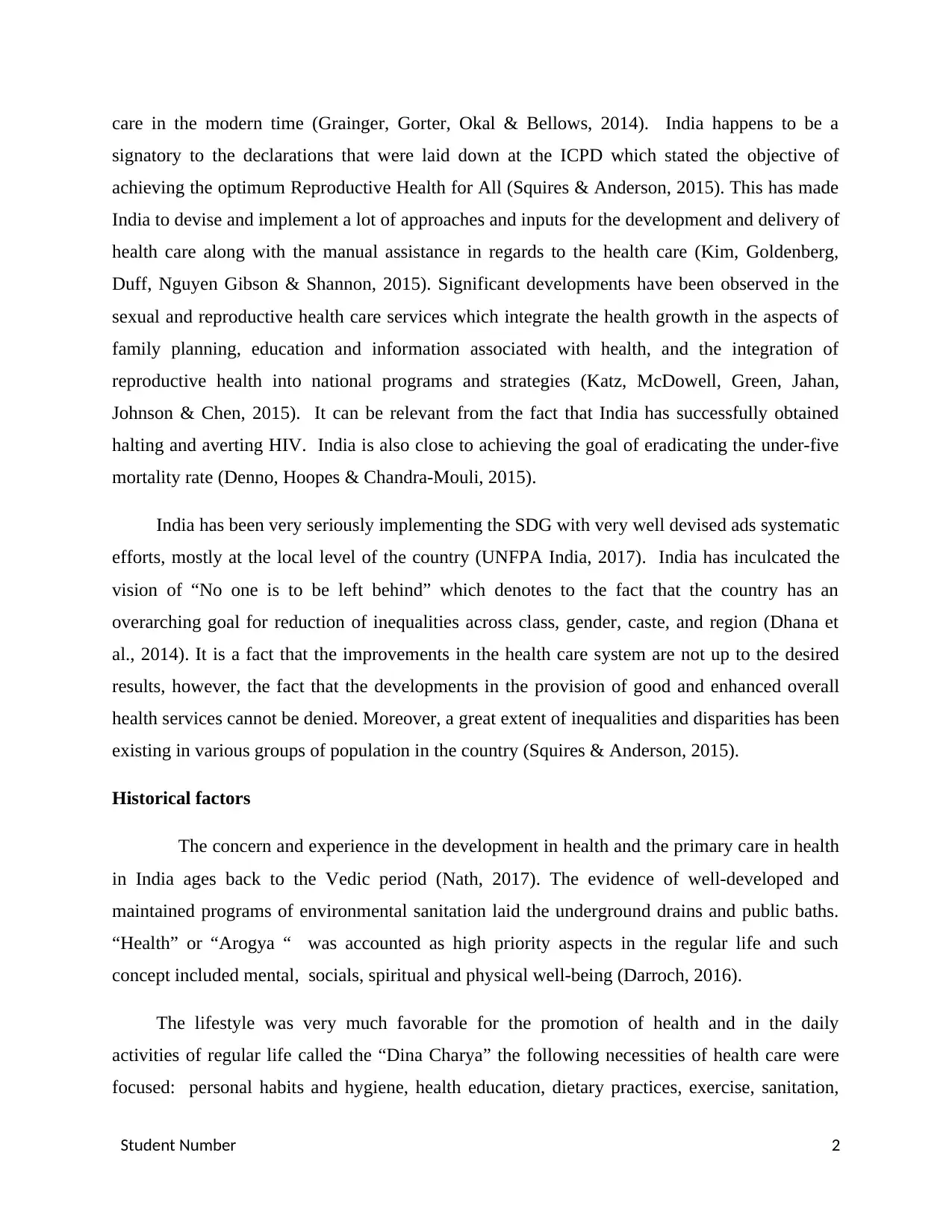
care in the modern time (Grainger, Gorter, Okal & Bellows, 2014). India happens to be a
signatory to the declarations that were laid down at the ICPD which stated the objective of
achieving the optimum Reproductive Health for All (Squires & Anderson, 2015). This has made
India to devise and implement a lot of approaches and inputs for the development and delivery of
health care along with the manual assistance in regards to the health care (Kim, Goldenberg,
Duff, Nguyen Gibson & Shannon, 2015). Significant developments have been observed in the
sexual and reproductive health care services which integrate the health growth in the aspects of
family planning, education and information associated with health, and the integration of
reproductive health into national programs and strategies (Katz, McDowell, Green, Jahan,
Johnson & Chen, 2015). It can be relevant from the fact that India has successfully obtained
halting and averting HIV. India is also close to achieving the goal of eradicating the under-five
mortality rate (Denno, Hoopes & Chandra-Mouli, 2015).
India has been very seriously implementing the SDG with very well devised ads systematic
efforts, mostly at the local level of the country (UNFPA India, 2017). India has inculcated the
vision of “No one is to be left behind” which denotes to the fact that the country has an
overarching goal for reduction of inequalities across class, gender, caste, and region (Dhana et
al., 2014). It is a fact that the improvements in the health care system are not up to the desired
results, however, the fact that the developments in the provision of good and enhanced overall
health services cannot be denied. Moreover, a great extent of inequalities and disparities has been
existing in various groups of population in the country (Squires & Anderson, 2015).
Historical factors
The concern and experience in the development in health and the primary care in health
in India ages back to the Vedic period (Nath, 2017). The evidence of well-developed and
maintained programs of environmental sanitation laid the underground drains and public baths.
“Health” or “Arogya “ was accounted as high priority aspects in the regular life and such
concept included mental, socials, spiritual and physical well-being (Darroch, 2016).
The lifestyle was very much favorable for the promotion of health and in the daily
activities of regular life called the “Dina Charya” the following necessities of health care were
focused: personal habits and hygiene, health education, dietary practices, exercise, sanitation,
Student Number 2
signatory to the declarations that were laid down at the ICPD which stated the objective of
achieving the optimum Reproductive Health for All (Squires & Anderson, 2015). This has made
India to devise and implement a lot of approaches and inputs for the development and delivery of
health care along with the manual assistance in regards to the health care (Kim, Goldenberg,
Duff, Nguyen Gibson & Shannon, 2015). Significant developments have been observed in the
sexual and reproductive health care services which integrate the health growth in the aspects of
family planning, education and information associated with health, and the integration of
reproductive health into national programs and strategies (Katz, McDowell, Green, Jahan,
Johnson & Chen, 2015). It can be relevant from the fact that India has successfully obtained
halting and averting HIV. India is also close to achieving the goal of eradicating the under-five
mortality rate (Denno, Hoopes & Chandra-Mouli, 2015).
India has been very seriously implementing the SDG with very well devised ads systematic
efforts, mostly at the local level of the country (UNFPA India, 2017). India has inculcated the
vision of “No one is to be left behind” which denotes to the fact that the country has an
overarching goal for reduction of inequalities across class, gender, caste, and region (Dhana et
al., 2014). It is a fact that the improvements in the health care system are not up to the desired
results, however, the fact that the developments in the provision of good and enhanced overall
health services cannot be denied. Moreover, a great extent of inequalities and disparities has been
existing in various groups of population in the country (Squires & Anderson, 2015).
Historical factors
The concern and experience in the development in health and the primary care in health
in India ages back to the Vedic period (Nath, 2017). The evidence of well-developed and
maintained programs of environmental sanitation laid the underground drains and public baths.
“Health” or “Arogya “ was accounted as high priority aspects in the regular life and such
concept included mental, socials, spiritual and physical well-being (Darroch, 2016).
The lifestyle was very much favorable for the promotion of health and in the daily
activities of regular life called the “Dina Charya” the following necessities of health care were
focused: personal habits and hygiene, health education, dietary practices, exercise, sanitation,
Student Number 2
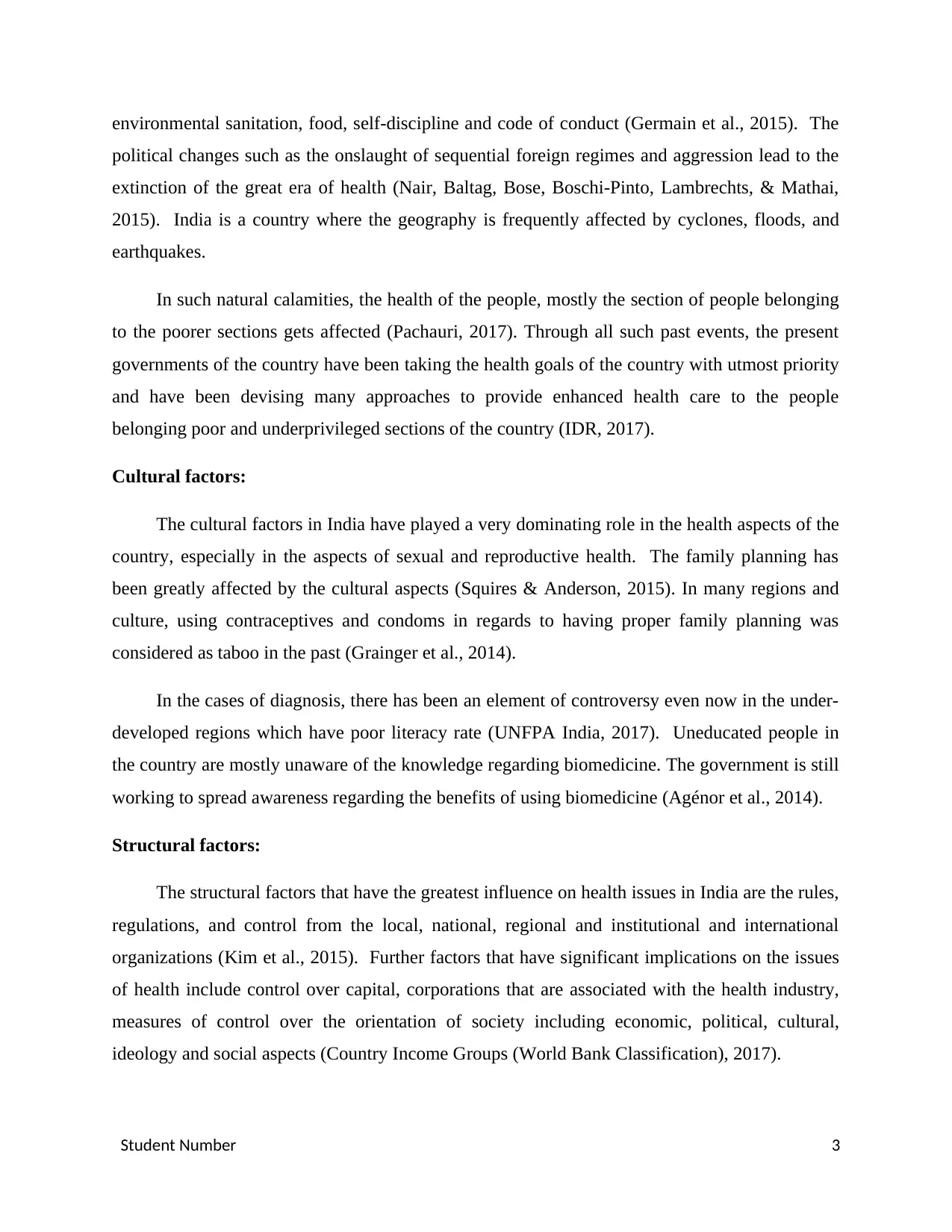
environmental sanitation, food, self-discipline and code of conduct (Germain et al., 2015). The
political changes such as the onslaught of sequential foreign regimes and aggression lead to the
extinction of the great era of health (Nair, Baltag, Bose, Boschi-Pinto, Lambrechts, & Mathai,
2015). India is a country where the geography is frequently affected by cyclones, floods, and
earthquakes.
In such natural calamities, the health of the people, mostly the section of people belonging
to the poorer sections gets affected (Pachauri, 2017). Through all such past events, the present
governments of the country have been taking the health goals of the country with utmost priority
and have been devising many approaches to provide enhanced health care to the people
belonging poor and underprivileged sections of the country (IDR, 2017).
Cultural factors:
The cultural factors in India have played a very dominating role in the health aspects of the
country, especially in the aspects of sexual and reproductive health. The family planning has
been greatly affected by the cultural aspects (Squires & Anderson, 2015). In many regions and
culture, using contraceptives and condoms in regards to having proper family planning was
considered as taboo in the past (Grainger et al., 2014).
In the cases of diagnosis, there has been an element of controversy even now in the under-
developed regions which have poor literacy rate (UNFPA India, 2017). Uneducated people in
the country are mostly unaware of the knowledge regarding biomedicine. The government is still
working to spread awareness regarding the benefits of using biomedicine (Agénor et al., 2014).
Structural factors:
The structural factors that have the greatest influence on health issues in India are the rules,
regulations, and control from the local, national, regional and institutional and international
organizations (Kim et al., 2015). Further factors that have significant implications on the issues
of health include control over capital, corporations that are associated with the health industry,
measures of control over the orientation of society including economic, political, cultural,
ideology and social aspects (Country Income Groups (World Bank Classification), 2017).
Student Number 3
political changes such as the onslaught of sequential foreign regimes and aggression lead to the
extinction of the great era of health (Nair, Baltag, Bose, Boschi-Pinto, Lambrechts, & Mathai,
2015). India is a country where the geography is frequently affected by cyclones, floods, and
earthquakes.
In such natural calamities, the health of the people, mostly the section of people belonging
to the poorer sections gets affected (Pachauri, 2017). Through all such past events, the present
governments of the country have been taking the health goals of the country with utmost priority
and have been devising many approaches to provide enhanced health care to the people
belonging poor and underprivileged sections of the country (IDR, 2017).
Cultural factors:
The cultural factors in India have played a very dominating role in the health aspects of the
country, especially in the aspects of sexual and reproductive health. The family planning has
been greatly affected by the cultural aspects (Squires & Anderson, 2015). In many regions and
culture, using contraceptives and condoms in regards to having proper family planning was
considered as taboo in the past (Grainger et al., 2014).
In the cases of diagnosis, there has been an element of controversy even now in the under-
developed regions which have poor literacy rate (UNFPA India, 2017). Uneducated people in
the country are mostly unaware of the knowledge regarding biomedicine. The government is still
working to spread awareness regarding the benefits of using biomedicine (Agénor et al., 2014).
Structural factors:
The structural factors that have the greatest influence on health issues in India are the rules,
regulations, and control from the local, national, regional and institutional and international
organizations (Kim et al., 2015). Further factors that have significant implications on the issues
of health include control over capital, corporations that are associated with the health industry,
measures of control over the orientation of society including economic, political, cultural,
ideology and social aspects (Country Income Groups (World Bank Classification), 2017).
Student Number 3
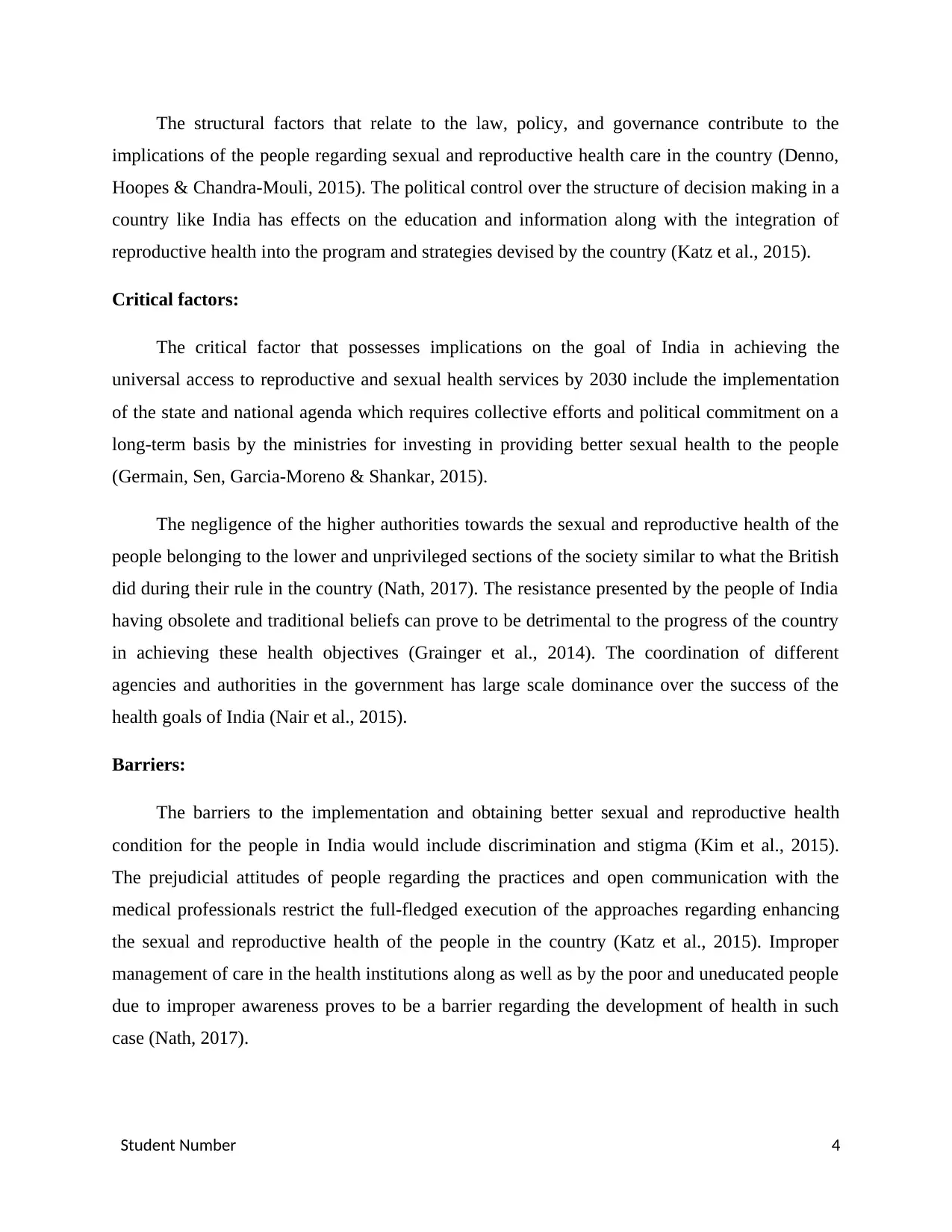
The structural factors that relate to the law, policy, and governance contribute to the
implications of the people regarding sexual and reproductive health care in the country (Denno,
Hoopes & Chandra-Mouli, 2015). The political control over the structure of decision making in a
country like India has effects on the education and information along with the integration of
reproductive health into the program and strategies devised by the country (Katz et al., 2015).
Critical factors:
The critical factor that possesses implications on the goal of India in achieving the
universal access to reproductive and sexual health services by 2030 include the implementation
of the state and national agenda which requires collective efforts and political commitment on a
long-term basis by the ministries for investing in providing better sexual health to the people
(Germain, Sen, Garcia-Moreno & Shankar, 2015).
The negligence of the higher authorities towards the sexual and reproductive health of the
people belonging to the lower and unprivileged sections of the society similar to what the British
did during their rule in the country (Nath, 2017). The resistance presented by the people of India
having obsolete and traditional beliefs can prove to be detrimental to the progress of the country
in achieving these health objectives (Grainger et al., 2014). The coordination of different
agencies and authorities in the government has large scale dominance over the success of the
health goals of India (Nair et al., 2015).
Barriers:
The barriers to the implementation and obtaining better sexual and reproductive health
condition for the people in India would include discrimination and stigma (Kim et al., 2015).
The prejudicial attitudes of people regarding the practices and open communication with the
medical professionals restrict the full-fledged execution of the approaches regarding enhancing
the sexual and reproductive health of the people in the country (Katz et al., 2015). Improper
management of care in the health institutions along as well as by the poor and uneducated people
due to improper awareness proves to be a barrier regarding the development of health in such
case (Nath, 2017).
Student Number 4
implications of the people regarding sexual and reproductive health care in the country (Denno,
Hoopes & Chandra-Mouli, 2015). The political control over the structure of decision making in a
country like India has effects on the education and information along with the integration of
reproductive health into the program and strategies devised by the country (Katz et al., 2015).
Critical factors:
The critical factor that possesses implications on the goal of India in achieving the
universal access to reproductive and sexual health services by 2030 include the implementation
of the state and national agenda which requires collective efforts and political commitment on a
long-term basis by the ministries for investing in providing better sexual health to the people
(Germain, Sen, Garcia-Moreno & Shankar, 2015).
The negligence of the higher authorities towards the sexual and reproductive health of the
people belonging to the lower and unprivileged sections of the society similar to what the British
did during their rule in the country (Nath, 2017). The resistance presented by the people of India
having obsolete and traditional beliefs can prove to be detrimental to the progress of the country
in achieving these health objectives (Grainger et al., 2014). The coordination of different
agencies and authorities in the government has large scale dominance over the success of the
health goals of India (Nair et al., 2015).
Barriers:
The barriers to the implementation and obtaining better sexual and reproductive health
condition for the people in India would include discrimination and stigma (Kim et al., 2015).
The prejudicial attitudes of people regarding the practices and open communication with the
medical professionals restrict the full-fledged execution of the approaches regarding enhancing
the sexual and reproductive health of the people in the country (Katz et al., 2015). Improper
management of care in the health institutions along as well as by the poor and uneducated people
due to improper awareness proves to be a barrier regarding the development of health in such
case (Nath, 2017).
Student Number 4
Secure Best Marks with AI Grader
Need help grading? Try our AI Grader for instant feedback on your assignments.
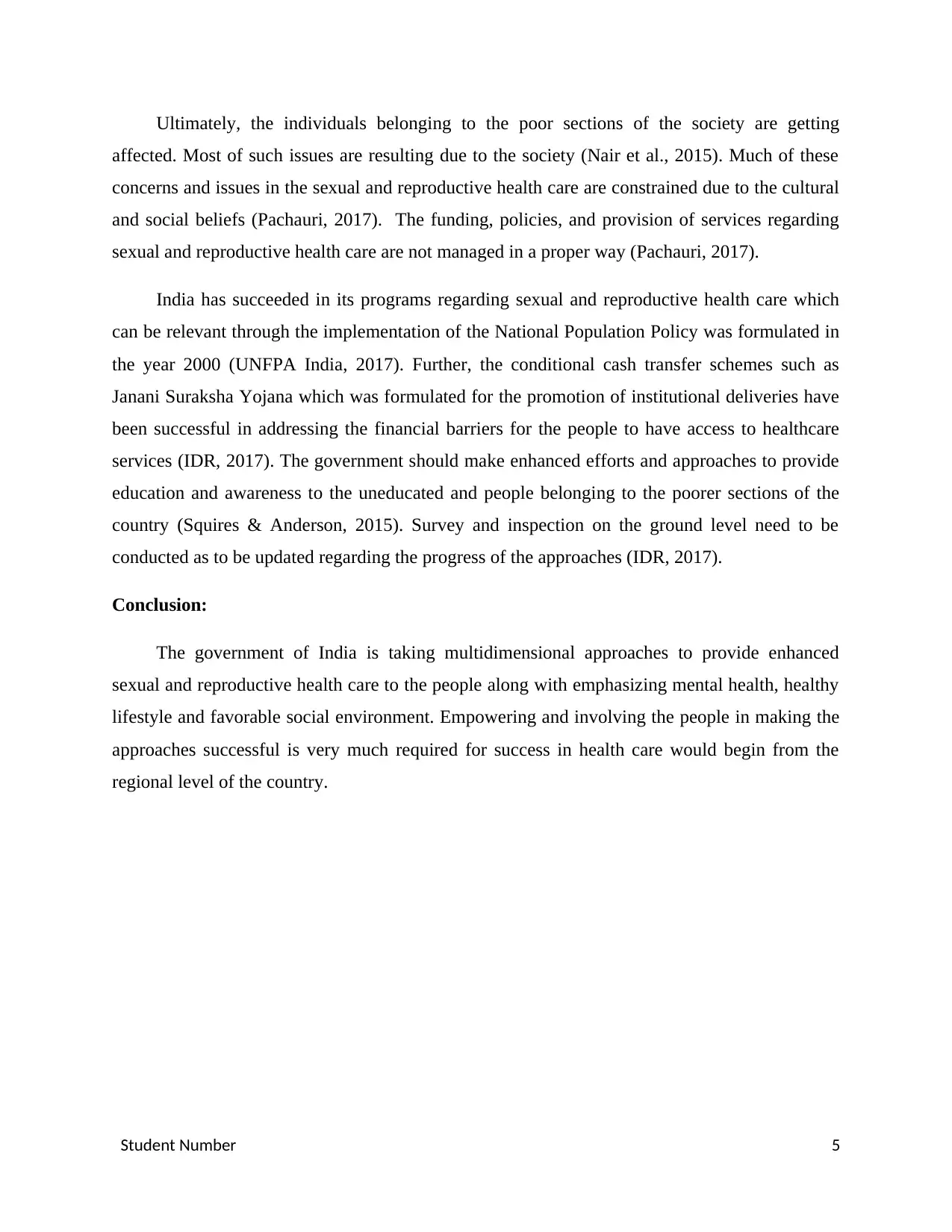
Ultimately, the individuals belonging to the poor sections of the society are getting
affected. Most of such issues are resulting due to the society (Nair et al., 2015). Much of these
concerns and issues in the sexual and reproductive health care are constrained due to the cultural
and social beliefs (Pachauri, 2017). The funding, policies, and provision of services regarding
sexual and reproductive health care are not managed in a proper way (Pachauri, 2017).
India has succeeded in its programs regarding sexual and reproductive health care which
can be relevant through the implementation of the National Population Policy was formulated in
the year 2000 (UNFPA India, 2017). Further, the conditional cash transfer schemes such as
Janani Suraksha Yojana which was formulated for the promotion of institutional deliveries have
been successful in addressing the financial barriers for the people to have access to healthcare
services (IDR, 2017). The government should make enhanced efforts and approaches to provide
education and awareness to the uneducated and people belonging to the poorer sections of the
country (Squires & Anderson, 2015). Survey and inspection on the ground level need to be
conducted as to be updated regarding the progress of the approaches (IDR, 2017).
Conclusion:
The government of India is taking multidimensional approaches to provide enhanced
sexual and reproductive health care to the people along with emphasizing mental health, healthy
lifestyle and favorable social environment. Empowering and involving the people in making the
approaches successful is very much required for success in health care would begin from the
regional level of the country.
Student Number 5
affected. Most of such issues are resulting due to the society (Nair et al., 2015). Much of these
concerns and issues in the sexual and reproductive health care are constrained due to the cultural
and social beliefs (Pachauri, 2017). The funding, policies, and provision of services regarding
sexual and reproductive health care are not managed in a proper way (Pachauri, 2017).
India has succeeded in its programs regarding sexual and reproductive health care which
can be relevant through the implementation of the National Population Policy was formulated in
the year 2000 (UNFPA India, 2017). Further, the conditional cash transfer schemes such as
Janani Suraksha Yojana which was formulated for the promotion of institutional deliveries have
been successful in addressing the financial barriers for the people to have access to healthcare
services (IDR, 2017). The government should make enhanced efforts and approaches to provide
education and awareness to the uneducated and people belonging to the poorer sections of the
country (Squires & Anderson, 2015). Survey and inspection on the ground level need to be
conducted as to be updated regarding the progress of the approaches (IDR, 2017).
Conclusion:
The government of India is taking multidimensional approaches to provide enhanced
sexual and reproductive health care to the people along with emphasizing mental health, healthy
lifestyle and favorable social environment. Empowering and involving the people in making the
approaches successful is very much required for success in health care would begin from the
regional level of the country.
Student Number 5
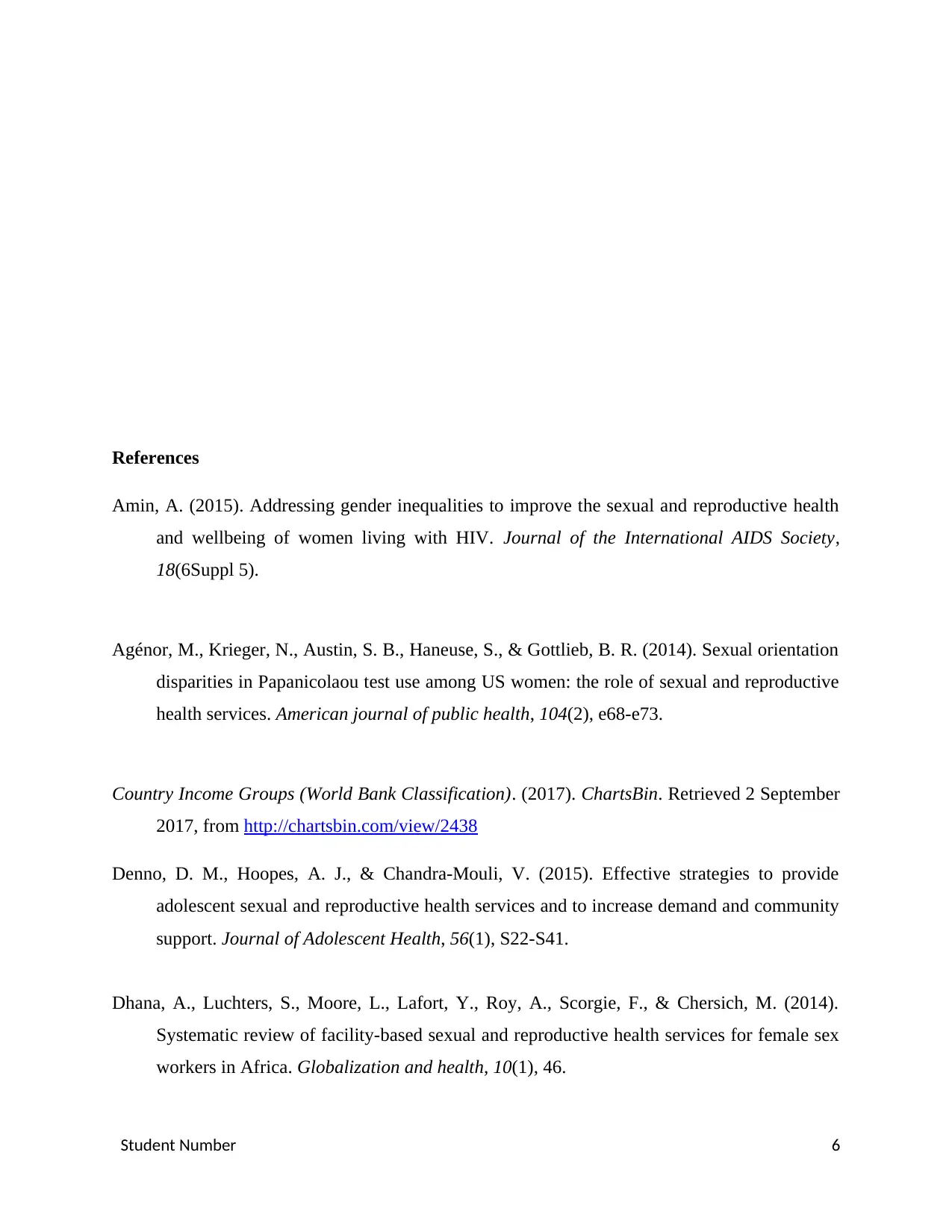
References
Amin, A. (2015). Addressing gender inequalities to improve the sexual and reproductive health
and wellbeing of women living with HIV. Journal of the International AIDS Society,
18(6Suppl 5).
Agénor, M., Krieger, N., Austin, S. B., Haneuse, S., & Gottlieb, B. R. (2014). Sexual orientation
disparities in Papanicolaou test use among US women: the role of sexual and reproductive
health services. American journal of public health, 104(2), e68-e73.
Country Income Groups (World Bank Classification). (2017). ChartsBin. Retrieved 2 September
2017, from http://chartsbin.com/view/2438
Denno, D. M., Hoopes, A. J., & Chandra-Mouli, V. (2015). Effective strategies to provide
adolescent sexual and reproductive health services and to increase demand and community
support. Journal of Adolescent Health, 56(1), S22-S41.
Dhana, A., Luchters, S., Moore, L., Lafort, Y., Roy, A., Scorgie, F., & Chersich, M. (2014).
Systematic review of facility-based sexual and reproductive health services for female sex
workers in Africa. Globalization and health, 10(1), 46.
Student Number 6
Amin, A. (2015). Addressing gender inequalities to improve the sexual and reproductive health
and wellbeing of women living with HIV. Journal of the International AIDS Society,
18(6Suppl 5).
Agénor, M., Krieger, N., Austin, S. B., Haneuse, S., & Gottlieb, B. R. (2014). Sexual orientation
disparities in Papanicolaou test use among US women: the role of sexual and reproductive
health services. American journal of public health, 104(2), e68-e73.
Country Income Groups (World Bank Classification). (2017). ChartsBin. Retrieved 2 September
2017, from http://chartsbin.com/view/2438
Denno, D. M., Hoopes, A. J., & Chandra-Mouli, V. (2015). Effective strategies to provide
adolescent sexual and reproductive health services and to increase demand and community
support. Journal of Adolescent Health, 56(1), S22-S41.
Dhana, A., Luchters, S., Moore, L., Lafort, Y., Roy, A., Scorgie, F., & Chersich, M. (2014).
Systematic review of facility-based sexual and reproductive health services for female sex
workers in Africa. Globalization and health, 10(1), 46.
Student Number 6
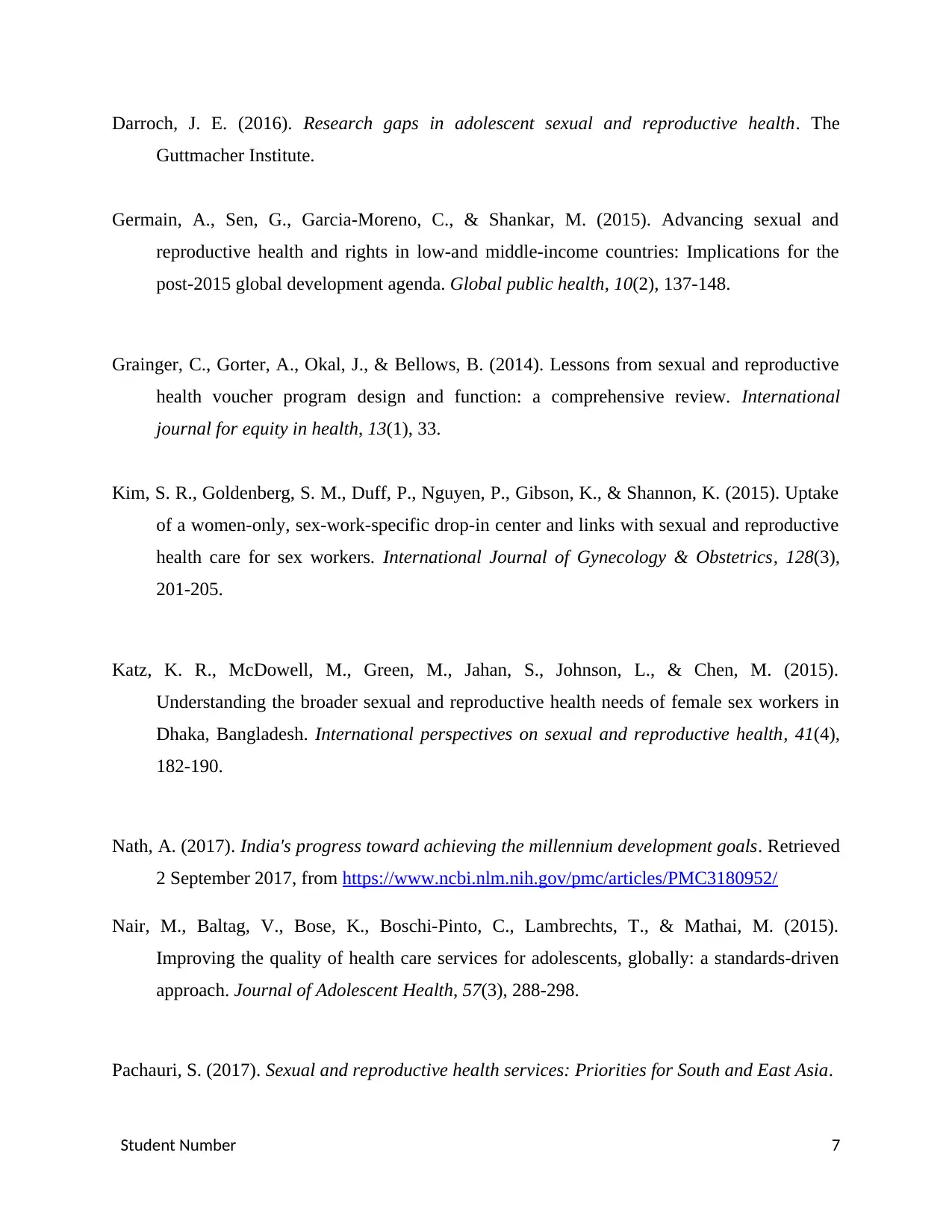
Darroch, J. E. (2016). Research gaps in adolescent sexual and reproductive health. The
Guttmacher Institute.
Germain, A., Sen, G., Garcia-Moreno, C., & Shankar, M. (2015). Advancing sexual and
reproductive health and rights in low-and middle-income countries: Implications for the
post-2015 global development agenda. Global public health, 10(2), 137-148.
Grainger, C., Gorter, A., Okal, J., & Bellows, B. (2014). Lessons from sexual and reproductive
health voucher program design and function: a comprehensive review. International
journal for equity in health, 13(1), 33.
Kim, S. R., Goldenberg, S. M., Duff, P., Nguyen, P., Gibson, K., & Shannon, K. (2015). Uptake
of a women‐only, sex‐work‐specific drop‐in center and links with sexual and reproductive
health care for sex workers. International Journal of Gynecology & Obstetrics, 128(3),
201-205.
Katz, K. R., McDowell, M., Green, M., Jahan, S., Johnson, L., & Chen, M. (2015).
Understanding the broader sexual and reproductive health needs of female sex workers in
Dhaka, Bangladesh. International perspectives on sexual and reproductive health, 41(4),
182-190.
Nath, A. (2017). India′s progress toward achieving the millennium development goals. Retrieved
2 September 2017, from https://www.ncbi.nlm.nih.gov/pmc/articles/PMC3180952/
Nair, M., Baltag, V., Bose, K., Boschi-Pinto, C., Lambrechts, T., & Mathai, M. (2015).
Improving the quality of health care services for adolescents, globally: a standards-driven
approach. Journal of Adolescent Health, 57(3), 288-298.
Pachauri, S. (2017). Sexual and reproductive health services: Priorities for South and East Asia.
Student Number 7
Guttmacher Institute.
Germain, A., Sen, G., Garcia-Moreno, C., & Shankar, M. (2015). Advancing sexual and
reproductive health and rights in low-and middle-income countries: Implications for the
post-2015 global development agenda. Global public health, 10(2), 137-148.
Grainger, C., Gorter, A., Okal, J., & Bellows, B. (2014). Lessons from sexual and reproductive
health voucher program design and function: a comprehensive review. International
journal for equity in health, 13(1), 33.
Kim, S. R., Goldenberg, S. M., Duff, P., Nguyen, P., Gibson, K., & Shannon, K. (2015). Uptake
of a women‐only, sex‐work‐specific drop‐in center and links with sexual and reproductive
health care for sex workers. International Journal of Gynecology & Obstetrics, 128(3),
201-205.
Katz, K. R., McDowell, M., Green, M., Jahan, S., Johnson, L., & Chen, M. (2015).
Understanding the broader sexual and reproductive health needs of female sex workers in
Dhaka, Bangladesh. International perspectives on sexual and reproductive health, 41(4),
182-190.
Nath, A. (2017). India′s progress toward achieving the millennium development goals. Retrieved
2 September 2017, from https://www.ncbi.nlm.nih.gov/pmc/articles/PMC3180952/
Nair, M., Baltag, V., Bose, K., Boschi-Pinto, C., Lambrechts, T., & Mathai, M. (2015).
Improving the quality of health care services for adolescents, globally: a standards-driven
approach. Journal of Adolescent Health, 57(3), 288-298.
Pachauri, S. (2017). Sexual and reproductive health services: Priorities for South and East Asia.
Student Number 7
Paraphrase This Document
Need a fresh take? Get an instant paraphrase of this document with our AI Paraphraser
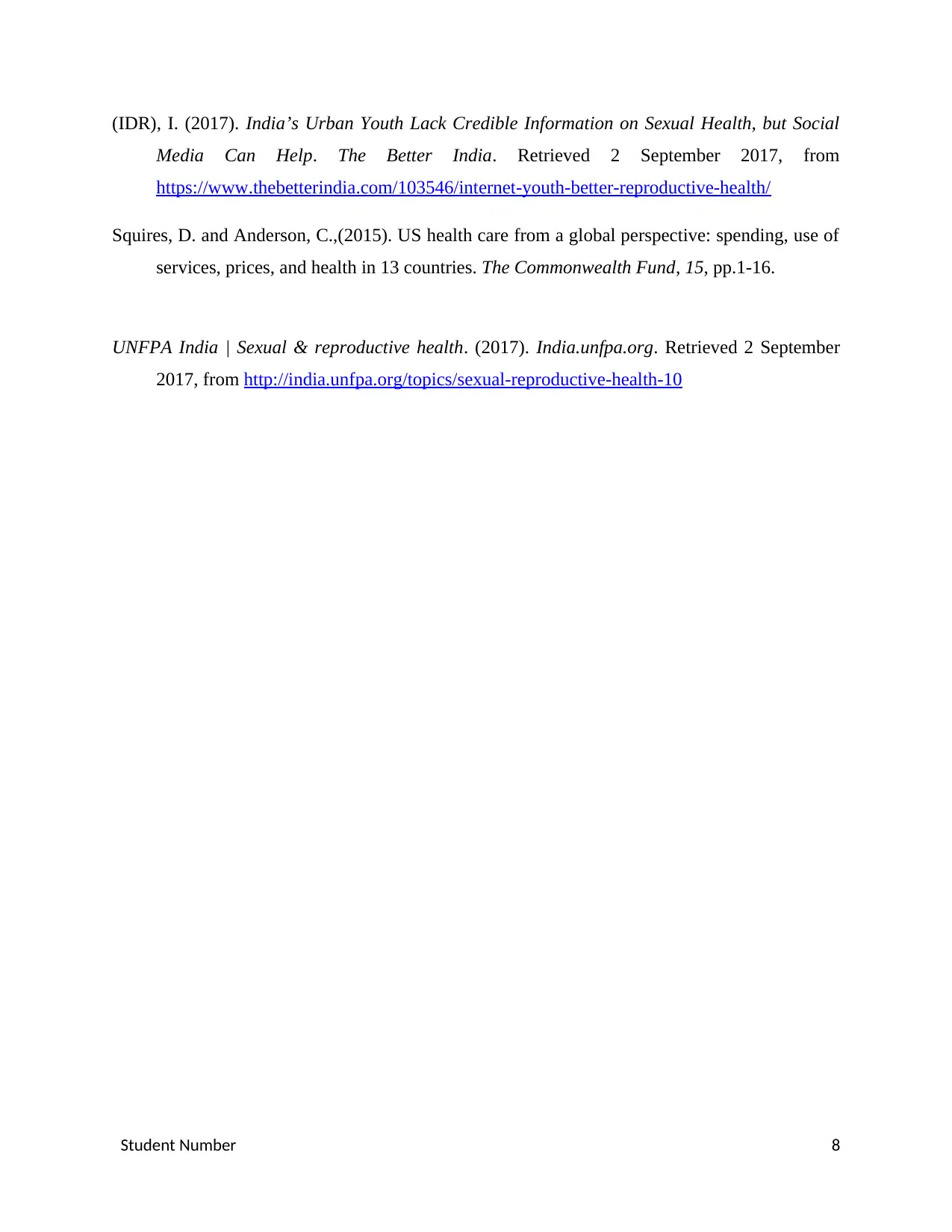
(IDR), I. (2017). India’s Urban Youth Lack Credible Information on Sexual Health, but Social
Media Can Help. The Better India. Retrieved 2 September 2017, from
https://www.thebetterindia.com/103546/internet-youth-better-reproductive-health/
Squires, D. and Anderson, C.,(2015). US health care from a global perspective: spending, use of
services, prices, and health in 13 countries. The Commonwealth Fund, 15, pp.1-16.
UNFPA India | Sexual & reproductive health. (2017). India.unfpa.org. Retrieved 2 September
2017, from http://india.unfpa.org/topics/sexual-reproductive-health-10
Student Number 8
Media Can Help. The Better India. Retrieved 2 September 2017, from
https://www.thebetterindia.com/103546/internet-youth-better-reproductive-health/
Squires, D. and Anderson, C.,(2015). US health care from a global perspective: spending, use of
services, prices, and health in 13 countries. The Commonwealth Fund, 15, pp.1-16.
UNFPA India | Sexual & reproductive health. (2017). India.unfpa.org. Retrieved 2 September
2017, from http://india.unfpa.org/topics/sexual-reproductive-health-10
Student Number 8
1 out of 8
Related Documents
Your All-in-One AI-Powered Toolkit for Academic Success.
+13062052269
info@desklib.com
Available 24*7 on WhatsApp / Email
![[object Object]](/_next/static/media/star-bottom.7253800d.svg)
Unlock your academic potential
© 2024 | Zucol Services PVT LTD | All rights reserved.





